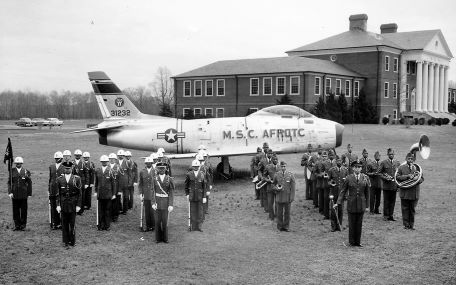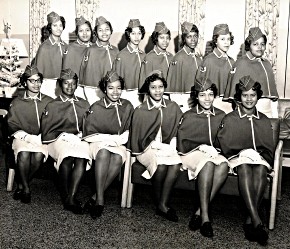
On Sep. 10, 1951, Maryland State College joined 187 other colleges and universities across the United States when it formed a Reserve Officers’ Training Corp detachment as an academic option for undergraduates. The goal of the new Air Force ROTC program was to recruit, educate and commission officer-candidates through course work that met U.S. Air Force standards.
For the next quarter century, the ROTC program — originally headquartered in (the first) Kiah Hall adjacent to John T. Williams Hall — offered instruction that provided committed graduates the option of a military career.
Annual activities included drill competitions, parades and community service. Cadets even made appearances on television. A few years after Maryland State’s ROTC unit was formed, an aerial photograph shows cadets in parade formation in front of Murphy Hall on the Academic Oval.
Early on, ROTC enjoyed a prominent stature on campus. The 1963 Hawk yearbook is dedicated to Col. Louis W. Cracken, the detachment commander, “because he is a good man who does good things from which we have all benefited.”
An annual “Pass and Review” ceremony in front of officials from the college and Air Force was conducted each spring. During the first weekend in April, the cadet corps closed out the school year with its annual “Military Day,” which consisted of competitions, aircraft exhibitions, demonstrations and music by an assortment of military bands. It was a day of celebration honoring cadets for scholastic achievement and other military-focused accolades.
While ROTC’s focus was on academics and military training, the program also brought a social element to campus life. Military Day activities closed out in style with an annual Military Ball at which cadets and their dates dressed in formal uniforms and gowns to celebrate the success during the school year.
Sam Frank Scales and Harold H. Rivers were the first Maryland State graduates to be commissioned as second lieutenants during the June 1, 1954 commencement exercises where former First Lady Eleanor Roosevelt was the featured speaker. Rivers retired from the Air Force as a lieutenant colonel.
Among alumni who found success in the military was Walter I. Jones , a Baltimore native who entered the Air Force as a second lieutenant in July 1974 after earning a math degree from UMES. He retired in 2004 as a highly decorated brigadier general.
Affiliated with UMES’ ROTC unit was the Benjamin O. Davis Jr. Squadron – Arnold Air Society, a professional honorary society of selected ROTC cadets and dedicated to advancing the ideas and tenets of Air Force leadership. The squadron sponsored the Angel Flight organization and performed public service activities at UMES and the surrounding community.
According to records at the Air Force ROTC headquarters, the last commissioning ceremony for student-cadets in the UMES ROTC detachment took place shortly after graduation in 1977.
Angel Flight

Prior to 1956, ROTC was all-male. An auxiliary group existed, but it was composed of female students who supported ROTC and assisted cadets in carrying out their activities. The organization, which eventually came to be known as Angel Flight, existed to provide “Aerospace Age” academic and social activities for women students who had interest in the military.
Angel Flight members participated in half-time ceremonies during football games, marching individually and performing alongside the college’s drill team. On some occasions, selected Angels were delegates to the Annual Conclave as well as Area Conclaves. An experimental Women’s Air Force ROTC was begun in 1956, but the women’s cadet program did not go national until 1970.
As the 1970s drew to a close, UMES’ ROTC and Angel Flight programs were deactivated. The last official presence of ROTC cadets in an official campus publication – the Hawk yearbook – was 1977.

